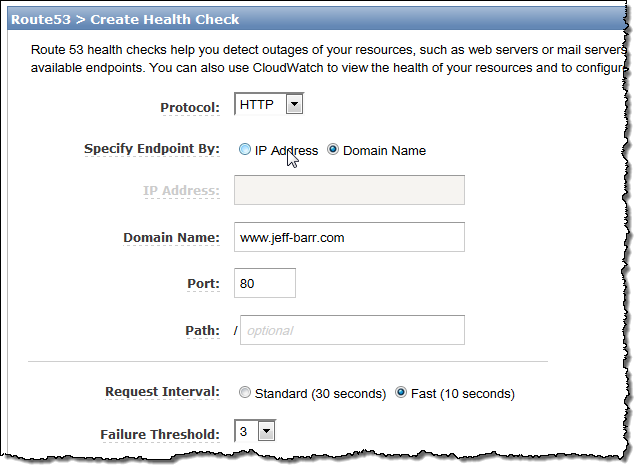AWS News Blog
Domain Name Health Checks for Route 53
Amazon Route 53 is a highly available and scalable Domain Name System (DNS) web service.
Last year we introduced Route 53 health checks. You can configure these health checks to route traffic to a backup website in the event that your primary website fails to respond as expected. We have since enhanced the basic health check model with the addition of string matching, support for HTTPS, and fast interval checks with configurable failover.
Today we are enhancing Route 53’s health check model with support for domain name health checks. This new option is an alternative to the existing support for health checks that are directed to a specific IP address.
You can use these health checks along with Route 53s DNS failover feature to help with improving the availability of your entire application by automatically routing requests only to healthy endpoints. For example, for a high-availability database scenario, you can create health checks against your primary and secondary database endpoints such as db-primary-1234.us-west-2.rds.amazonaws.com and db-secondary-1234.us-west-2.rds.amazonaws.com, even though they may have changing IP addresses (for services like Amazon RDS, the IP addresses can and do change, so its important to use the DNS name to define these endpoints instead of using the endpoints the current IP address). You can then create CNAMEs for db.example.com that point to your primary and secondary endpoints, enable the Failover routing policy and associate these CNAME records with the health checks. Your application layer would connect to db.example.com for database access and Route 53s health checks and DNS failover will automatically route requests from your application layer to the right database instance based on their health. Here’s a diagram to show you how this all fits together in practice:

You can configure this new type of health check from the AWS Management Console, the AWS CLI, or the Route 53 APIs.
From the AWS Management Console, select the Domain Name option for the endpoint, and then enter the domain name to be checked:

The DNS is re-resolved (in other words, the domain name is translated to an IP address) every time Route 53 performs a health check. The default interval between health checks is 30 seconds unless you have enabled fast interval health checks; in that case the interval is 10 seconds.
For both type of endpoints, Route 53 performs the health checks from multiple locations. Each location does its own DNS resolution; if the name being checked is using latency-based routing or is part of a content delivery network (CDN) Route 53 will check different endpoints as appropriate. This will give you a more accurate indication of the overall global health and accessibility of your application.
This new feature is available now and you can start using it today!
— Jeff;